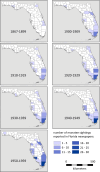Historical ecology reveals the "surprising" direction and extent of shifting baselines for the Florida manatee (Trichechus manatus latirostis)
- PMID: 39565986
- PMCID: PMC11578630
- DOI: 10.1371/journal.pone.0313070
Historical ecology reveals the "surprising" direction and extent of shifting baselines for the Florida manatee (Trichechus manatus latirostis)
Abstract
Historical data are often overlooked in risk assessments and recovery plans for marine animals, resulting in the "shifting baselines." Historical ecological studies demonstrate the "surprising" extent to which contemporary assumptions misrepresent premodern baselines. The Florida manatee, a subspecies of the West Indian manatee found primarily in Florida, USA, faces several existential threats, but risk assessments and recovery targets for the species are hindered by poor understanding of historical baselines. We conducted systematic and opportunistic reviews of archaeological and historical records of manatee occurrence in Florida, USA. Our data reveal that manatee populations in Florida were very small in the Precolonial and Colonial Periods, possibly representing infrequent in-migration from the Caribbean during favorable climate conditions. Manatees expanded in number and range across the Florida peninsula during the Territorial/Early Statehood and Early Modern Periods, first northward on the Atlantic Coast and later along the coast of the Gulf of Mexico. These expansions track increasing human populations, associated anthropogenic landscape alterations, and social and policy changes. Historical ecology is critical for "shaping a better Anthropocene" for humans and manatees in Florida.
Copyright: © 2024 Pluckhahn, Thulman. This is an open access article distributed under the terms of the Creative Commons Attribution License, which permits unrestricted use, distribution, and reproduction in any medium, provided the original author and source are credited.
Conflict of interest statement
The authors have declared that no competing interests exist.
Figures
Similar articles
-
Internal parasites of the two subspecies of the West Indian manatee Trichechus manatus.Dis Aquat Organ. 2018 Sep 10;130(2):145-152. doi: 10.3354/dao03270. Dis Aquat Organ. 2018. PMID: 30198489
-
Normal Hemostatic Profiles and Coagulation Factors in Healthy Free-Living Florida Manatees ( Trichechus manatus latirostris).J Wildl Dis. 2016 Oct;52(4):907-911. doi: 10.7589/2015-12-328. Epub 2016 Aug 15. J Wildl Dis. 2016. PMID: 27525595
-
Toward principles of historical ecology.Am J Bot. 2017 May;104(5):645-648. doi: 10.3732/ajb.1700070. Epub 2017 May 17. Am J Bot. 2017. PMID: 28515077 No abstract available.
-
Chapter 25: headache: an historical outline.Handb Clin Neurol. 2010;95:375-86. doi: 10.1016/S0072-9752(08)02125-8. Handb Clin Neurol. 2010. PMID: 19892128 Review. No abstract available.
-
Infection control through the ages.Am J Infect Control. 2012 Feb;40(1):35-42. doi: 10.1016/j.ajic.2011.02.019. Epub 2011 Jul 23. Am J Infect Control. 2012. PMID: 21783278 Review.
References
-
- U.S. Fish and Wildlife Service (FWS), Department of the Interior (2017). Endangered and threatened wildlife and plants; reclassification of the West Indian Manatee from endangered to threatened. Federal Register, 82(64), 16668–16704.
-
- Florida Fish and Wildlife Conservation Commission (FWC) (2024). Manatee mortality event along the East Coast: 2020-ongoing. Electronic document, https://myfwc.com/research/manatee/rescue-mortality-response/ume/
-
- Laist D. W., & Reynolds J. E. III (2005). Florida manatees, warm-water refuges, and an uncertain future. Coastal Management, 33(3), 279–295.
-
- Valade J., Mezich R., Smith K., Merrill M., & Calleson T. (2020). Florida Manatee Warm-Water Action Plan. U.S. Fish & Wildlife Service and Florida Fish and Wildlife Conservation Commission. Electronic document, https://cffw.org/wp-content/uploads/2021/03/Warm-Water-Manatee-Action-Pl...
Publication types
MeSH terms
LinkOut - more resources
Full Text Sources









